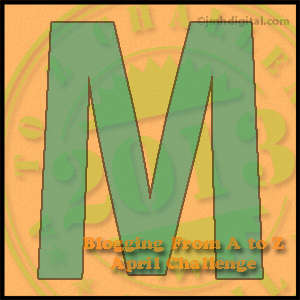 In D&D a handful of fantasy races populate the majority of the gaming world – Human, Elf, Dwarf, Half-Elf, and Halfling. These are the most common and well known races, but they’re certainly not the only ones. Over the years the D&D has allowed players to choose from a multitude of races when creating their characters. The Half-Orc, Gnome, Drow, Warforged, Goliath and even Dragonborn have all become commonplace in today’s D&D. As the list was expanded the game’s creators provided an explanation of how the new races fit into the world. In most cases these races had distinct culture and homelands in the same way as the Elves and Dwarves.
In D&D a handful of fantasy races populate the majority of the gaming world – Human, Elf, Dwarf, Half-Elf, and Halfling. These are the most common and well known races, but they’re certainly not the only ones. Over the years the D&D has allowed players to choose from a multitude of races when creating their characters. The Half-Orc, Gnome, Drow, Warforged, Goliath and even Dragonborn have all become commonplace in today’s D&D. As the list was expanded the game’s creators provided an explanation of how the new races fit into the world. In most cases these races had distinct culture and homelands in the same way as the Elves and Dwarves.
Over the years I’ve played my fair share of non-Human characters. Since 4e I’ve played an Elf, Dwarf, Eladrin, Half-Orc, Goliath, Drow, Shifter, Half-Elf, Warforged, and Dragonborn just to name the first few that come to mind. In my mind these are all “normal” races for a fantasy role-playing game. Sure a few of them might be a bit on the fringes of normal (the Goliath, Warforged and Dragonborn, for example), but I have no problem grouping these races in the same category as Humans, Elves and Dwarves. More to the point I do not consider these races to be monsters.
Throughout April Dungeon’s Master is participating in the Blogging from A to Z Challenge. The challenge is to write a new article ever day in April, excluding Sundays. That’s 26 articles over the course of the month. To make things even more interesting the title of each article will begin with a different letter of the alphabet. Today the “M” is for Monster as we venture into the possibility of having players run monsters as characters.
When I think of monsters I think of a creature that’s really big (like a Giant) or something distinctly non-humanoid (like a Displacer Beast). It’s a fine line, but I think most D&D players know where to draw it. In 4e D&D the line was moved a few yards when more and more of the humanoid monsters were added to the playable race list. Before 4e I’d always considered Kobolds, Bugbears, Minotaurs, and Bullywugs to be monsters. Now I can choose any of these as playable races.
I suppose when you think about it all of the monsters that you can play as PCs do have a lot in common. They’re all bipedal humanoids with a way to communicate and functional limbs that can carry weapons. It’s not like you can play a character that’s Gelatinous Cube… at least not in a regular game.
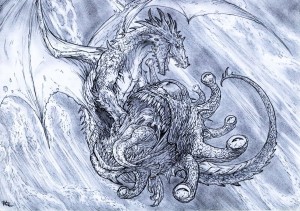
In a recent campaign my party found themselves in the midst of a power struggle between Dragons and Beholders. We knew that eventually these two groups would face off against each other and depending on which group was victorious it would send the campaign in one of two directions. We spent hours figuring out what we’d do once we learned the outcome of the confrontation. Then we looked to the DM to tell us what happened next. Did the Beholders kill the Dragons or did the Dragons kill the Beholders? His answer: “I don’t know.”
Normally the DM runs all the monsters. In this case he wanted to try something different. Because there was so much at stake the DM didn’t want to just pick a winner arbitrarily nor did he want to flip a coin and let chance decide. Instead he handed out copies of Beholder and Dragon monster stats and the players took on the roles of monsters. The fate of the campaign, and by extension the fate of our characters, was in our hands in a way it had never been before. We were going to play the monsters as characters.
This was a thrilling new experience for us. We’d all had the chance to be the DM before so running monsters wasn’t new, but the absence of heroes was. This was a full on monster fight. For this one battle royal our characters were the most iconic creatures in D&D: Beholders and Dragons.
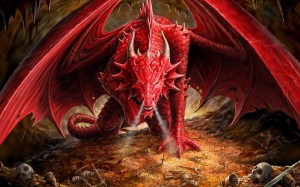 Playing monsters was something completely new and different for us. Monsters are not set up like normal characters. With PCs the expectation is that you’ll have many balanced combat encounters, that you’ll survive each and then fight again later. The expectation with most monsters is that the PCs will kill it and after one fight it’s done. Our DM didn’t want our monster characters to drop in one round so he deliberately chose solo monsters. These are monsters that are roughly as powerful as a whole party of adventurers. So it wasn’t just a party of Dragons against a party of Beholders, it was the equivalent of multiple adventuring parties against multiple adventuring parties.
Playing monsters was something completely new and different for us. Monsters are not set up like normal characters. With PCs the expectation is that you’ll have many balanced combat encounters, that you’ll survive each and then fight again later. The expectation with most monsters is that the PCs will kill it and after one fight it’s done. Our DM didn’t want our monster characters to drop in one round so he deliberately chose solo monsters. These are monsters that are roughly as powerful as a whole party of adventurers. So it wasn’t just a party of Dragons against a party of Beholders, it was the equivalent of multiple adventuring parties against multiple adventuring parties.
The encounter was spectacular. It’s refreshing when, even after years of playing D&D, a creative DM can come up with something new to challenge and excite players. This fight was unlike any we’d ever played before. On the surface the monsters stat blocks were pretty straight forward. Remember that they’re intended to be used by the DM along with a handful of other monsters, so the sheets need to be as basic as possible. But basic isn’t boring. As solo monsters they had powers that let them act more than once on their turn and most had triggered actions or powers that recharged.
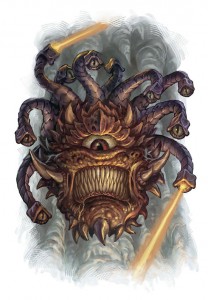 As with any 4e D&D combat, the map and terrain features were as important as the participants in the fight. The DM provided a lot of hazards and obstacles that challenged creatures that could fly, breathe fire, and see in all directs. The combat took all night but it was great. We completely forgot that this fight actually had significance on our ongoing campaign. We took on the roles of these monsters and played them as fanatically as we would any of our own characters. In the end the Beholders won, but they too suffered considerably losses. When the PCs eventually faced the remaining Beholders the signs of their fight against the Dragons were still evident.
As with any 4e D&D combat, the map and terrain features were as important as the participants in the fight. The DM provided a lot of hazards and obstacles that challenged creatures that could fly, breathe fire, and see in all directs. The combat took all night but it was great. We completely forgot that this fight actually had significance on our ongoing campaign. We took on the roles of these monsters and played them as fanatically as we would any of our own characters. In the end the Beholders won, but they too suffered considerably losses. When the PCs eventually faced the remaining Beholders the signs of their fight against the Dragons were still evident.
Playing the monsters as character was thrilling. But it’s not something I think I’d want to do with any regularity; at least not in 4e D&D. As mentioned above the monster stat blocks are basic. After one or two fights I’d get bored. I’d need to know that there was some way for my monster PC to advance and grow as a character. This isn’t something that the 4e mechanics allow for in non-humanoid monsters. For that, we have to look back to the previous edition.
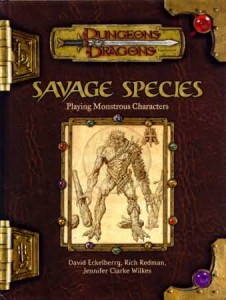 One of my favourite books from 3.5e D&D was Savage Species. It allowed players to become monsters in a balanced way. If you wanted to play a Dragon PC you could. However, you didn’t begin as a full fledged Dragon. The creature’s abilities were divided up over many levels and you only got access to a few at a time. This maintained some balance and let a low level adventuring party have Dragon among its ranks without the Dragon consistently hogging the spotlight because it was so much more powerful than the other PCs. Since you didn’t begin play as the uber-powerful Dragon it allowed you to grow and develop into the monster. Over many levels you could develop your monster character just as you would any other PC.
One of my favourite books from 3.5e D&D was Savage Species. It allowed players to become monsters in a balanced way. If you wanted to play a Dragon PC you could. However, you didn’t begin as a full fledged Dragon. The creature’s abilities were divided up over many levels and you only got access to a few at a time. This maintained some balance and let a low level adventuring party have Dragon among its ranks without the Dragon consistently hogging the spotlight because it was so much more powerful than the other PCs. Since you didn’t begin play as the uber-powerful Dragon it allowed you to grow and develop into the monster. Over many levels you could develop your monster character just as you would any other PC.
Running monsters as player characters is an interesting idea and an interesting experiment. It’s not something I’d recommend for newer players or newer DMs, but for the experienced gamers it might be something to try once. I’d hesitate before allowing a full fledged monster into the party, even if the DM found a way to make it work. Despite the acceptance that most D&D societies have for the bizarre humanoid races, I don’t see any village allowing you to spend the night if you had a Storm Giant or Blue Dragon in the party.
Have you even played a strange monster as a PC? How did it work out? How did you keep it balanced? Has your DM ever asked the players to run monsters? If you could play a monster as a character which would you choose?
 Looking for instant updates? Subscribe to the Dungeon’s Master feed!
Looking for instant updates? Subscribe to the Dungeon’s Master feed!
2 replies on “Monsters as Player Characters”
I’ve done this for an extended campaign in 3.5. We used the ECL to adjust for this, but we did have problems with how imbalanced the monsters were against each other. Even with ECL, a race with a lot of unusual abilities can be serious threats. Another issue to be concerned about is abnormally high stats. We ended up with a Flind, a Pixie, a redeemed Succubus, and a Sharn.
Sharn are creatures from Faerun that have – flight (40′ perfect); 9 hands with claws or that can wield weapons (3 primary, 6 secondary); 3 bites; 10′ reach; spellcasting as a 7th level sorcerer and 5th level cleric; hex portals (three magic windows within 100′ that they can use to see, attack, and cast spells through); DR 10/cold iron; they get an extra standard action each round (and can cast two spells as long as they are from different classes); evasion; immune to mind-affecting spells and polymorph; regeneration 2(lawful); alertness, multiattack and multiweapon fighting as bonus feats; Str 18, Dex 20, Con 20, Int 18, Wis 18, Cha 20. All for 4 hit dice and LA +5.
—–
We are now considering a sequel campaign in Pathfinder. The Advanced Race guide is pretty flexible. It can do reasonable facsimiles of a lot of different monsters and yet keep them balanced.
I wonder if you could play as the monsters like a vampire, zombie, succubus, ect.